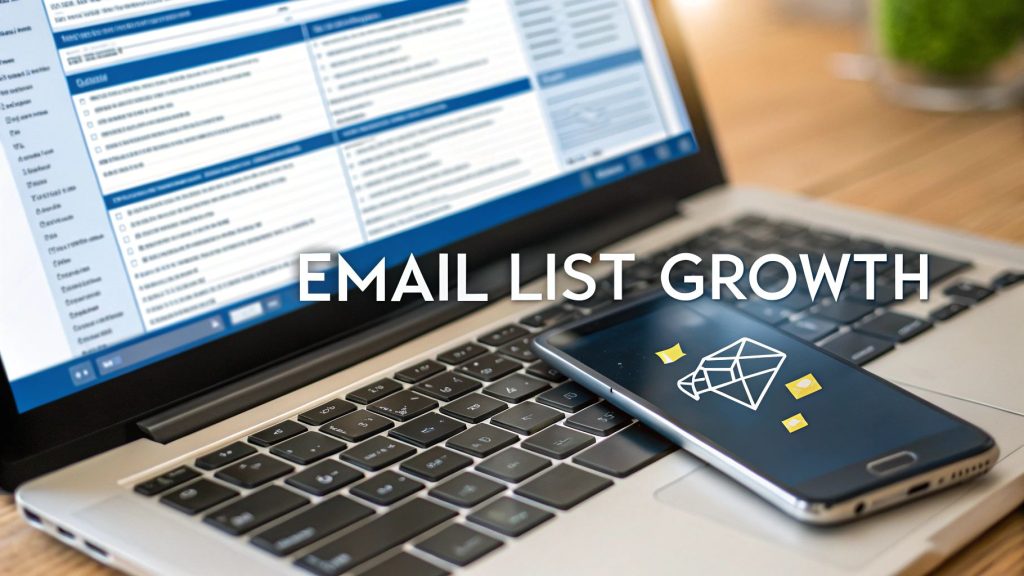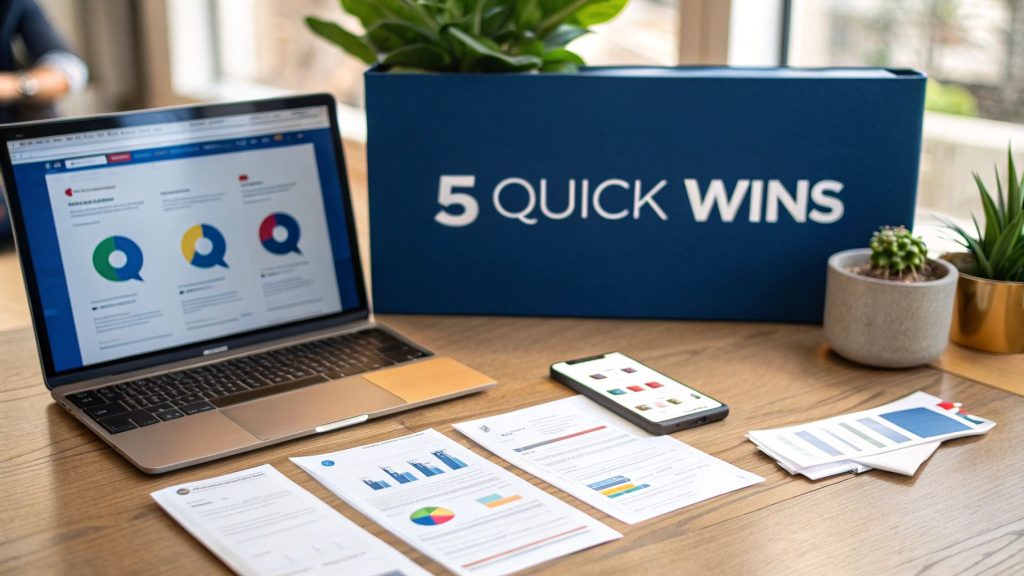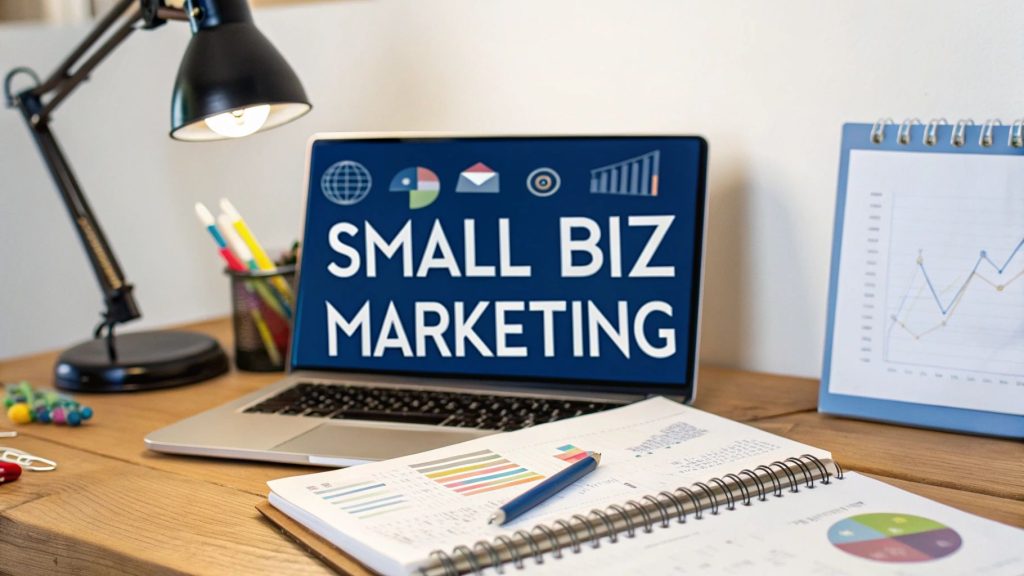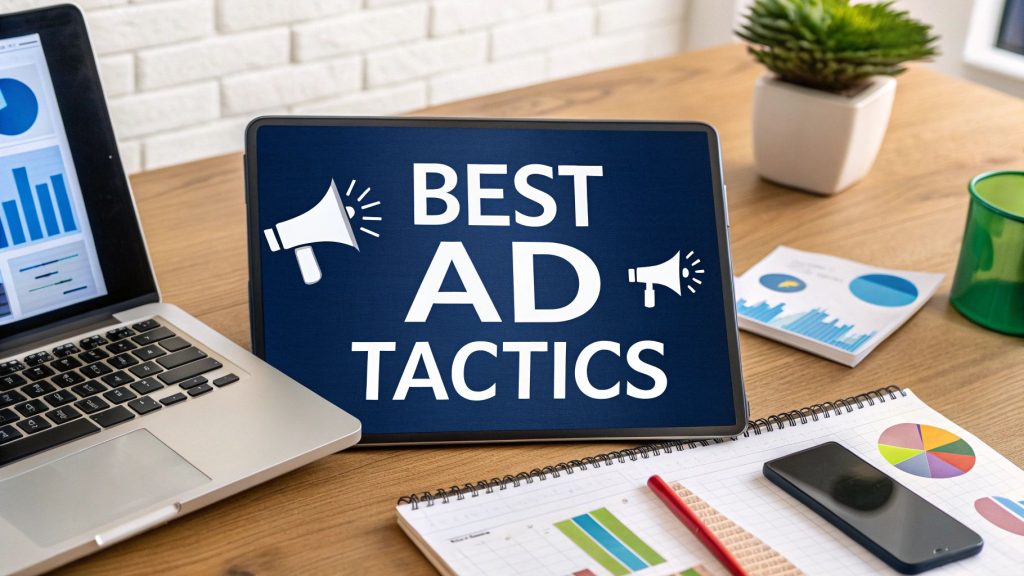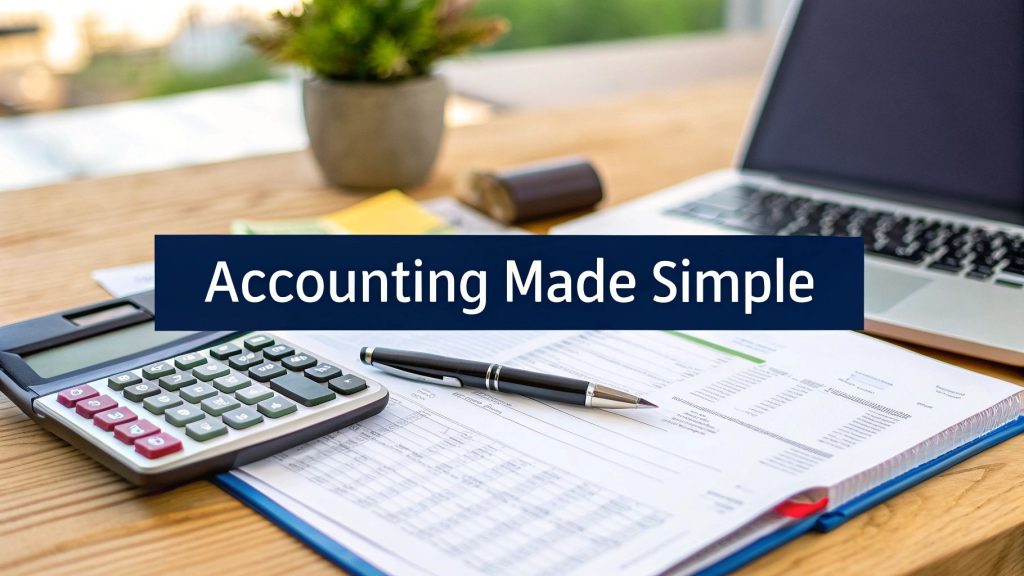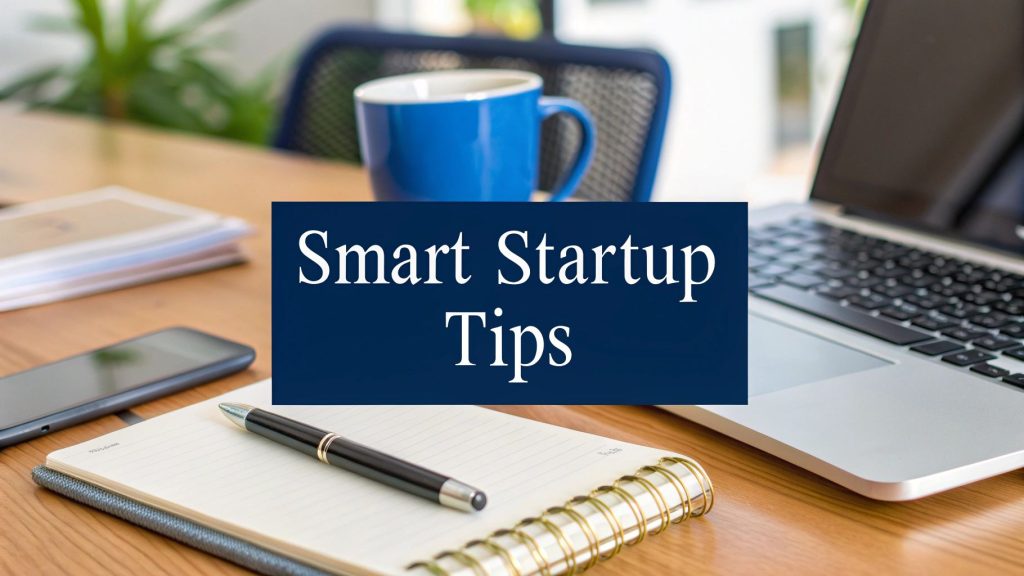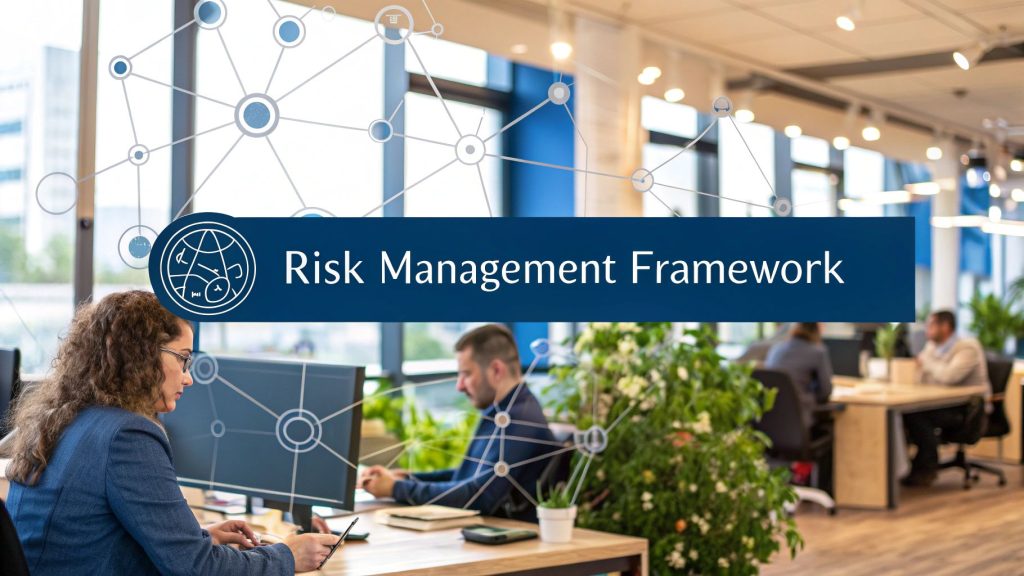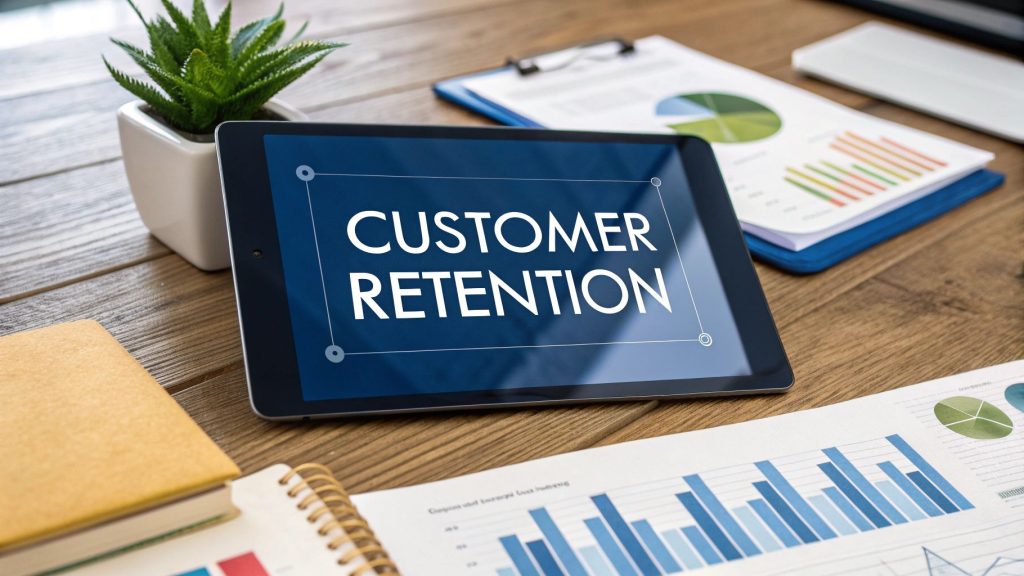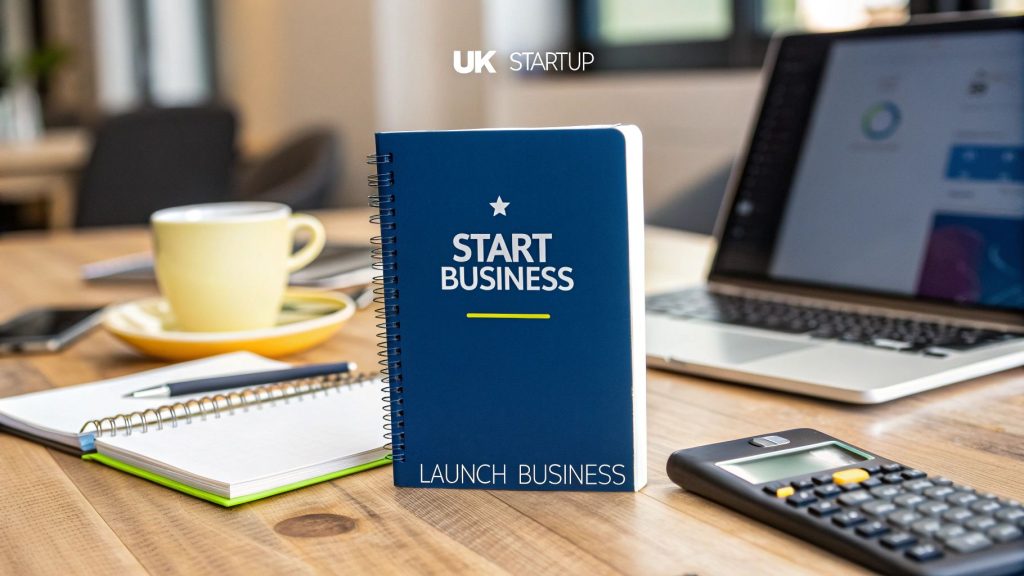How to Scale a Business The Right Way
Scaling a business isn’t just about getting bigger; it’s about getting bigger, smarter. The real goal is to increase your revenue at a much faster rate than your costs. It’s the difference between hiring a new person for every ten new customers versus building a system that can handle a thousand new customers with minimal extra spend. It’s about creating a repeatable, profitable model that won’t collapse when the orders start flooding in.
Is Your Business Ready to Scale?
Before you hit the accelerator, you need to take an honest look under the bonnet. Is your business actually ready for the pressure of rapid expansion? It’s a critical question because scaling too early can be a fatal mistake. I’ve seen promising businesses turn into a chaotic mess of cash flow problems and operational failures simply because they jumped the gun.
The excitement is understandable. Optimism among UK business leaders is high right now, with 83% feeling confident about the year ahead and 56% predicting profit growth. You can see the full breakdown in the latest business confidence survey. But confidence alone isn’t enough; it has to be built on a rock-solid, scalable foundation.
This means you need to be sure that your current success isn’t just a fluke. You need a predictable, repeatable system for generating revenue. It’s like the difference between a one-hit-wonder and an artist with a long, successful career.
Confirming Your Product-Market Fit
The first litmus test is genuine product-market fit. This goes way beyond just having a few happy customers. It’s about having a devoted following who actively seek you out and would be genuinely gutted if you disappeared tomorrow. The clearest signs are high customer retention rates and a steady stream of word-of-mouth referrals.
Take a small, UK-based artisan coffee roaster I know. Before they even thought about investing in a bigger facility, they obsessed over their subscription box data. What they found was gold: over 70% of customers stayed subscribed for more than six months, and new sign-ups from organic recommendations were growing by 15% every single quarter. That data told them they had a loyal audience and a product people genuinely wanted, not just a passing trend.
Before we dive deeper, it’s worth understanding the core differences between simple business growth and strategic scaling.
Growth vs Scaling Key Differences
Many people use “growth” and “scaling” interchangeably, but they represent fundamentally different approaches to expansion. This table breaks down the key distinctions.
| Aspect | Growth | Scaling |
|---|---|---|
| Resources | Adding resources (staff, capital) in direct proportion to revenue. | Increasing revenue without a significant increase in resources. |
| Efficiency | Focus is on increasing sales, even if it means higher costs. | Focus is on improving systems and efficiency to boost profitability. |
| Structure | Often reactive; processes are added as problems arise. | Proactive; building systems and infrastructure ahead of demand. |
| Goal | To get bigger and increase market share. | To increase revenue exponentially while keeping costs manageable. |
Understanding this distinction is crucial. Growth can be messy and expensive, whereas scaling is about intentional, efficient expansion.
This infographic neatly compares the signals of a business that’s truly ready to scale versus one that still needs more time to mature its processes.
As you can see, readiness is all about having stable, established systems in place, rather than relying on reactive, inconsistent heroics to get things done.
Evaluating Operational and Financial Stability
Next, turn your attention to your internal workings. If your orders doubled overnight, would your operations grind to a halt? The coffee roaster, for example, secured contracts with two additional bean suppliers before they expanded. This was a smart, proactive move to ensure their supply chain could handle the extra demand without sacrificing the quality of their product or causing frustrating delays.
A business ready for scaling has systems that run the business, and people who run the systems. If your success depends entirely on the heroic efforts of one or two key individuals, you are not ready.
Finally, your finances have to be robust. Predictable revenue and healthy profit margins are non-negotiable. You need a crystal-clear understanding of your cash flow, customer acquisition costs (CAC), and customer lifetime value (LTV). These aren’t just numbers for a spreadsheet; they are the vital signs of your business’s health. A thorough assessment is essential, and you can learn more by exploring our guide to a business risk management framework.
Securing the Right Funding for Expansion

Scaling a business almost always means you’re going to need a serious injection of cash. But let’s be clear: not all money is good money. Securing the wrong type of funding—with restrictive terms or mismatched expectations—can strangle your growth just as effectively as having no capital at all.
Your financial strategy needs to be every bit as robust as your operational one. The real goal isn’t just to find cash, but to find a funding partner whose vision actually aligns with yours. The right backer brings more than just money to the table; they offer expertise and open doors to their network. This means shifting your mindset from simply getting a loan to strategically building a financial foundation that can support your long-term ambitions.
Looking Beyond Traditional Bank Loans
While popping down to your high-street bank for a business loan is a familiar path, it’s far from the only one—especially for ambitious tech ventures or innovative companies in the UK. Many of the businesses I see successfully scaling are looking elsewhere, turning to equity investment and specialised grants.
When you explore these avenues, the conversation changes completely. Instead of being grilled on your historical balance sheets and company assets, the focus shifts to your future potential, the size of your market opportunity, and the strength of your leadership team.
For UK businesses ready to make that leap, here are a few of the main funding routes to consider:
- Angel Investors: These are high-net-worth individuals who invest their own money into promising young businesses in exchange for an equity stake. Often, they bring invaluable mentorship and industry connections, acting more like a partner than just a lender. For example, a sustainable packaging startup might secure funding from an angel who previously built and sold a logistics company, gaining not just capital but deep industry expertise.
- Venture Capital (VC) Firms: VCs invest pooled funds from larger institutions into high-potential start-ups and scale-ups. They write bigger cheques than angels and usually take a board seat, playing an active role in shaping the company’s direction. Be prepared—they’re looking for businesses capable of delivering 10x returns or more.
- Government Grants: If your business operates in sectors like technology, sustainability, or R&D, UK bodies like Innovate UK offer non-dilutive funding. This is essentially “free” money that doesn’t require you to give up any equity, making it an incredibly attractive option if you qualify. For instance, a medical tech firm developing a new diagnostic tool could receive a grant to fund its clinical trials.
Crafting a Compelling Investment Case
It doesn’t matter who you’re pitching to; you need to present a rock-solid case that inspires absolute confidence. This goes way beyond a cool idea. It requires meticulous financial modelling and a believable, data-backed roadmap to profitability. Investors need to see, without a shadow of a doubt, that you know your numbers inside-out and have a clear plan to generate a return on their cash.
“Investors don’t fund businesses; they fund business models. Your pitch must clearly articulate how every pound of their capital will be used to generate a significant multiple in return. It’s about demonstrating a predictable engine for growth, not just a passion project.”
A huge part of this is your business plan, and specifically, the executive summary. This is often the first—and sometimes only—document an investor will read. If it doesn’t immediately grab their attention and communicate the scale of the opportunity, you won’t get a second look. To see how to build a powerful narrative, it’s worth reviewing some effective business plan executive summary examples.
A Real-World Fintech Example
Think about the journey of a UK-based fintech start-up getting ready for its Series A funding round. They didn’t just walk in with a big vision. They came to the table armed with a detailed financial model that projected their user acquisition costs, customer lifetime value, and churn rates for the next three to five years.
Their presentation showed exactly how the investment would be used to scale their marketing, hire key engineering talent, and hit specific user growth milestones. They left no room for doubt, showing investors precisely how their capital would translate into tangible results.
This is the kind of preparation that separates the businesses that get funded from those that don’t. Their detailed forecasting and transparent approach ultimately secured them £5 million from a leading London VC firm, giving them the fuel they needed for their next stage of expansion.
Building Your Operations and Tech Stack

The manual processes that got your business off the ground will become the very anchors that hold it back during expansion. We’ve all been there. What was once a manageable spreadsheet for tracking orders or a shared inbox for customer queries quickly turns into a bottleneck that stifles growth, frustrates your team, and damages the customer experience.
Knowing how to scale a business effectively means systematically replacing those manual, time-sucking tasks with a smart, interconnected operational backbone. This isn’t about buying every flashy piece of software on the market, but about strategically building a ‘tech stack’—a collection of tools that actually talk to each other to automate the mundane and free up your people for high-value work.
This approach is central to the success of many fast-growing UK companies. In fact, the UK’s scale-up businesses have shown incredible growth, achieving an average annual revenue increase of 43% over the past three years. This impressive performance, driven by firms maintaining over 20% annual growth, highlights just how powerful efficient, scalable systems can be. You can explore more findings about the UK’s fastest-growing firms and their strategies.
Mapping Your Processes to Find Bottlenecks
Before you can fix your operational weaknesses, you have to find them. The best way to do this is to literally map out your core business processes from start to finish. Grab a whiteboard or a big sheet of paper and trace the customer journey. How does a new lead become a paying customer? What are the exact steps from an order being placed to it being delivered?
This exercise is always an eye-opener. It will quickly reveal the hidden friction points and repetitive tasks that are silently consuming your team’s time and energy.
Once you have this map, look for the biggest constraints. Common culprits I see time and again include:
- Manual Data Entry: A team member copying information from your e-commerce site into your accounting software. Every. Single. Time.
- Repetitive Communication: Sending the same follow-up emails or answering the same customer questions over and over again.
- Inventory Discrepancies: A lack of real-time visibility between your sales channels and your actual stock levels, leading to overselling.
- Disjointed Customer View: Your sales, marketing, and support teams all having separate, incomplete pictures of a customer’s history.
These are the areas where a small investment in the right technology can deliver a massive return.
A Practical E-commerce Example
Imagine an online fashion brand that experiences a 300% surge in orders after a successful marketing campaign. Without scalable systems, this dream scenario quickly becomes a nightmare.
Staff would be manually updating stock levels, drowning in shipping labels, and completely unable to keep up with customer service emails. The result? Shipping delays, angry customers, and a burnt-out team.
A scalable solution involves integrating key systems. By connecting their e-commerce platform (like Shopify) to an inventory management system and a customer relationship management (CRM) tool, they create a seamless flow of information.
When an order is placed, stock levels are automatically updated across all channels, the customer is added to the CRM for future marketing, and a shipping label is generated without a single manual click. This is the essence of operational scaling.
This integration means they can handle that massive order volume with their existing team, avoiding the cost and complexity of hiring more admin staff just to keep up.
Choosing the Right Technology
With your bottlenecks identified, you can now select the right tools for the job. The goal is to build an integrated tech stack where data flows freely between applications. This creates a single source of truth and eliminates the errors and wasted time that come from manual data handling.
Getting your tech stack right is fundamental to smooth scaling. Here’s a breakdown of the essential software categories every growing business should consider, along with some popular tools in each space.
Essential Tech Stack for a Scaling Business
| Business Area | Technology Type | Example Tools |
|---|---|---|
| Sales & Marketing | Customer Relationship Management (CRM) | HubSpot, Salesforce, Zoho |
| Operations | Inventory Management System | Cin7, Unleashed, Katana |
| Finance | Cloud Accounting Software | Xero, QuickBooks, Sage |
| Team Communication | Internal Messaging & Project Management | Slack, Microsoft Teams, Asana |
| Customer Support | Help Desk Software | Zendesk, Gorgias, Intercom |
A word of advice: start small. Implement one key piece of software that solves your biggest bottleneck first. Get your team properly trained on it, and then build from there, integrating new tools as your needs evolve. The aim is to create an operational engine that runs smoothly in the background, supporting your growth without needing constant manual intervention.
Scaling Your Team and Culture
Your systems, processes, and funding are crucial, but they’re only half the story. At the end of the day, a business is scaled by its people. Get this wrong, and you’ll burn through cash, dilute your culture, and create chaos.
A common trap is to hire too quickly or for the wrong reasons. Truly knowing how to scale a business means being as strategic about your team as you are about your technology stack. The mindset has to shift from hiring for today’s problems to building a team that can conquer tomorrow’s challenges. It’s about proactive team building, not just plugging gaps.
Hiring for Where You Are Going
Most founders hire when they feel the pressure. The inbox is overflowing, customers are waiting, and the workload is overwhelming. That’s reactive hiring. A business built to scale, however, hires ahead of the curve.
You need to look at your business plan and pinpoint the skills that will be critical in six to twelve months. Will you need a dedicated Head of Marketing to build a repeatable customer acquisition engine? Or is a Customer Success Manager the key to driving down churn and improving retention?
Making that first hire is a massive step, and getting it right sets the tone for everything that follows. It’s about so much more than filling a seat; it’s about finding someone who buys into your vision and has the potential to grow with the business. For a deep dive into this, you might find our ultimate guide to hiring your first employee helpful.
The biggest mistake you can make is trying to clone yourself. As you scale, you need to bring in people who are smarter than you in specific areas. Your job has to change from being the ‘doer’ of everything to the conductor of an orchestra of experts.
Delegation isn’t just about handing off tasks you don’t like. It’s about empowering your team with real ownership. When people feel trusted and responsible for outcomes, they become more engaged and innovative—exactly the energy you need to fuel rapid growth.
A Case Study in Smooth Scaling
Let’s look at a real-world example. A UK software-as-a-service (SaaS) company needed to triple its development team to hit its product roadmap goals. Instead of just throwing new coders at the problem, they paused and did something smart first. They invested time in meticulously documenting their entire development workflow and coding standards.
Next, they created a structured, week-long onboarding process. This wasn’t just a technical handover; it was a deep immersion into the company’s mission and its core culture of autonomy. That initial time investment paid off massively.
The results were telling:
- Reduced Chaos: New developers were able to contribute meaningfully to the codebase within their first two weeks, a huge improvement on their old, ad-hoc approach.
- Increased Innovation: With clear guidelines and a culture of trust, the team started shipping new features 30% faster.
- Stronger Culture: The deliberate focus on values during onboarding meant that as the team grew, the core culture actually got stronger, not weaker.
This company dodged the classic pitfalls of rapid hiring. They built a system to integrate new talent effectively, turning their team into a genuine asset for scaling.
Protecting Your Culture During Growth
Your company culture is the invisible glue that holds everything together. It guides how your team collaborates, solves problems, and treats customers. During a period of rapid expansion, it’s incredibly easy for this unique culture to get diluted or lost entirely.
Protecting it requires intentional, consistent effort. It means taking your core values off the poster on the wall and embedding them into your daily operations. You can do this by weaving them into:
- Hiring Decisions: Ask interview questions that specifically test for alignment with your values. Don’t just look for skills; look for mindset. For example, if a core value is “customer obsession,” ask candidates to describe a time they went above and beyond for a customer.
- Performance Reviews: Evaluate employees not just on what they achieve, but how they achieve it. Did they collaborate effectively? Did they take ownership?
- Public Recognition: Celebrate and highlight team members who live and breathe the company’s core principles. This could be a “Values Champion” award in a monthly team meeting.
A strong team and culture are vital, especially in the UK business landscape. The private sector is dominated by SMEs—99.9% of all businesses—which collectively provide around 16.64 million jobs. As these businesses scale, the unique culture that made them successful in the first place becomes their key differentiator. By putting your people first, you build a resilient organisation that can not only handle the pressures of growth but thrive on them.
Building a Predictable Customer Acquisition Engine

Hope is not a scalable marketing strategy. If your plan for getting new customers relies on luck, chance encounters, or one-off viral moments, you don’t have a business ready for scaling—you have a lottery ticket. To truly grow, you need a reliable, repeatable system for bringing a predictable number of new customers through the door every single month.
This system is your customer acquisition engine. Building it means shifting from random acts of marketing to a deliberate, data-driven process. The goal is to identify your most profitable channels and then systematically pour resources into them to generate consistent returns. It’s the difference between hoping for leads and manufacturing them on demand.
Identifying Your Most Profitable Channels
Not all marketing channels are created equal. The secret to an efficient acquisition engine is figuring out which one or two channels deliver the best customers for the lowest cost. Spreading your budget thinly across every platform is a classic mistake that just leads to mediocre results everywhere.
You need to test, measure, and then double down on what’s actually working. Your most effective channels could be anything from:
- Paid Advertising: Using platforms like Google Ads or LinkedIn Ads to target specific demographics and keywords with surgical precision.
- Content Marketing: Creating genuinely valuable blog posts, guides, or videos that attract your ideal customer through organic search and establish you as a trusted authority.
- Strategic Partnerships: Collaborating with complementary, non-competing businesses to tap into their existing, relevant customer base.
- Direct Outreach: A structured sales process involving targeted emails, calls, or networking for high-value B2B clients.
The only way to know for sure is to track everything. Every lead and every sale should be attributed back to its original source. This is the data that will tell you exactly where your marketing pounds are generating the highest return.
A Practical B2B Service Provider Example
Let’s look at a UK-based B2B consultancy that helps businesses with digital transformation. In their early days, they tried a bit of everything: some social media, a few networking events, and the odd blog post. Their lead flow was inconsistent and completely unpredictable.
To fix this, they got systematic. First, they built incredibly detailed customer personas for their ideal clients—not just their job titles, but their specific pain points, their goals, and where they hang out online looking for information. This clarity was a game-changer.
Next, they mapped the entire buyer journey in their CRM, from the very first point of contact right through to the final signed contract. This gave them a clear view of where leads were coming from and which activities were most effective at moving them through the sales funnel.
They discovered that while networking events generated plenty of conversations, it was their in-depth articles on process automation that consistently attracted highly qualified leads through organic search. These leads were already educated on the problem and were much closer to making a buying decision.
Based on this insight, they shifted 80% of their marketing budget into content creation and SEO. The result? Within six months, their inbound lead volume had tripled, and their sales process became far more predictable and efficient. They had finally built their engine.
Obsessing Over the Right Metrics
Building a customer acquisition engine isn’t a “set it and forget it” task; it demands constant monitoring and optimisation. You simply cannot scale what you do not measure. There are two metrics, in particular, that you must become obsessed with.
These two figures tell you everything you need to know about the health and scalability of your acquisition strategy.
- Customer Acquisition Cost (CAC): This is the total cost of your sales and marketing efforts divided by the number of new customers you acquired in a set period. It tells you, in plain terms, exactly how much it costs to win a new customer.
- Lifetime Value (LTV): This is the total revenue you can reasonably expect to generate from a single customer over the entire duration of your business relationship. It represents the long-term worth of each new customer.
The relationship between these two numbers is the golden rule of scalable growth.
For a business model to be viable and scalable, your LTV must be significantly higher than your CAC. A common benchmark to aim for is an LTV:CAC ratio of at least 3:1.
If you spend £500 to acquire a customer who will only ever spend £400 with you, you are on a fast track to failure. But if that £500 acquisition brings in a customer with an LTV of £2,000, you have a profitable engine you can confidently pour more fuel into. Understanding these metrics is fundamental to knowing how to scale a business because it ensures every pound you spend on marketing is driving profitable, sustainable growth.
Got Questions About Scaling? You’re Not Alone.
As you start mapping out your company’s growth, it’s completely normal for questions and a bit of uncertainty to creep in. Knowing how to scale a business isn’t just about sticking to a plan; it’s about knowing how to handle the inevitable hurdles and tough calls that come with ambition.
Let’s tackle some of the most common questions we hear from founders across the UK.
When Is the Right Time to Hire My First Manager?
This is a huge step, and the timing is less about hitting a magic revenue number and more about your own capacity. The right time to hire your first manager is when you, the founder, become the bottleneck. Simple as that.
If you find yourself spending more time bogged down in day-to-day tasks and answering team questions than you do on the big-picture stuff—like chasing funding, building partnerships, or refining your business model—it’s time. A good manager doesn’t just manage people; they free you up to focus on growing the business, not just running it.
I remember a founder of a boutique digital marketing agency who realised she was spending 60% of her week just reviewing junior staff’s work and managing project timelines. By bringing in an Operations Manager, she got those hours back. She immediately poured that time into high-value client acquisition and doubled their new business pipeline in just six months.
How Do I Know If I’m Scaling Too Fast?
Believe it or not, scaling too quickly can be just as dangerous as not scaling at all. The warning signs are often subtle at first, but they can quickly spiral if you ignore them.
The clearest red flag of unsustainable growth is when your key business metrics start to go backwards. If customer satisfaction scores are dipping, good people are leaving, or product quality is slipping, you’re moving too fast.
Keep a close eye on these signals:
- Cash Flow Strain: Are you constantly chasing payments or scrambling to make payroll, even though revenues are climbing? This is a classic sign that your costs are outpacing your income.
- Cultural Dilution: Does the office feel different, and not in a good way? If new hires don’t seem to get “how we do things around here,” your culture is likely eroding under the pressure of rapid expansion.
- Service Failures: A sudden spike in customer complaints, negative reviews, and a growing backlog of support tickets are all signs your operations can no longer keep up with demand.
Should I Outsource Key Functions or Hire In-House?
Ah, the classic dilemma. The answer really depends on how critical the function is to what makes your business special. A good rule of thumb I always follow is to keep your core competencies in-house and outsource everything else.
Your core competency is your secret sauce—the unique value you provide that sets you apart. For a software company, that’s your product development. For a craft brewery, it’s the brewing process itself. These are the functions you should own, protect, and perfect internally.
On the other hand, non-core functions are often better off outsourced, especially in the early stages of scaling.
- Real-World Example: I worked with a growing e-commerce brand that decided to outsource its warehousing and fulfilment to a third-party logistics (3PL) provider. This move saved them from a massive capital investment in a warehouse and staff. Instead, they funnelled that cash into marketing and product development—their true core activities. It was a game-changer, allowing them to handle a 5x increase in order volume without missing a beat.
Functions like payroll, IT support, and even some highly specialised marketing tasks can almost always be handled more efficiently and cost-effectively by external experts.
Navigating the complexities of scaling requires a solid foundation of knowledge and strategic planning. At Grow My Acorn, we provide the resources and guidance to help entrepreneurs, startups, and company directors make informed decisions at every stage of their growth journey. Explore our comprehensive guides at https://growmyacorn.co.uk.




